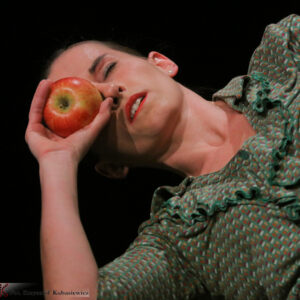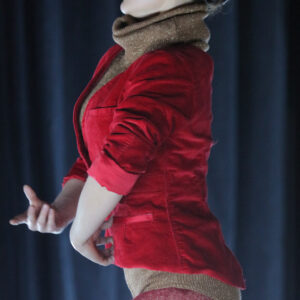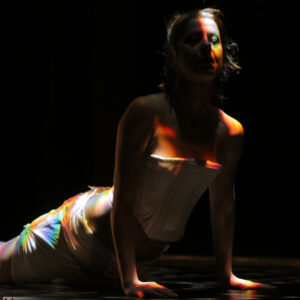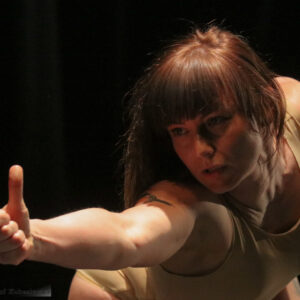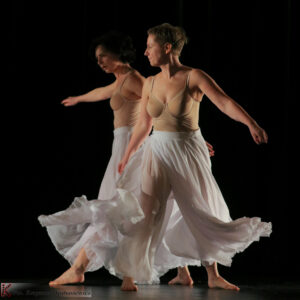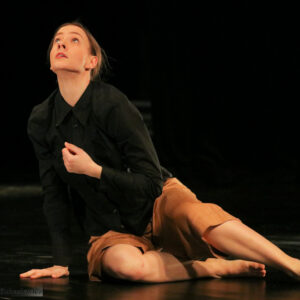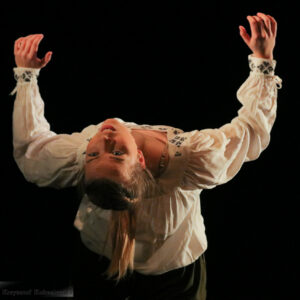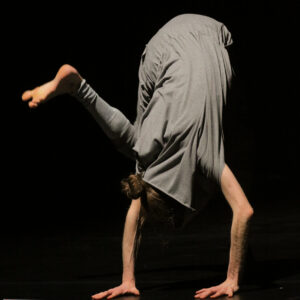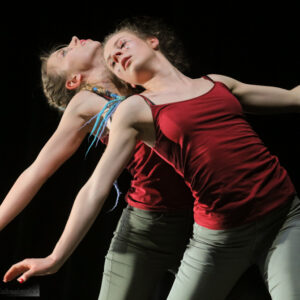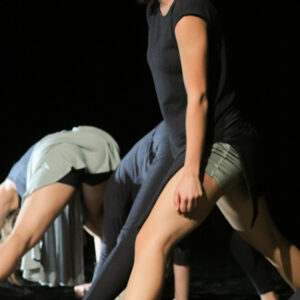Festival report from the not-quite-besieged city
Movement Sphere in Nowa Sól
Sfera Ruchu is a network of dance theater festivals carried out in three centers (in Słupsk, Toruń, Nowa Sól / Zielona Góra) for almost ten years. From year to year, it attracts more and more artists and critics, becoming a strong competition for more promoted events, carried out in large centers.
Enchanted by its potential and richness of offers (along with the performances, workshops and discussion panels are held there), I noted some of my festival reminiscences to dissolve the word that right next to prestigious scenes closed in my own world, not peripheral magic takes place.
There are performances that electrify even experienced viewers and make the sensation hold your breath. During this year's Sphere of Movement, this feeling accompanied me several times - from the show of "Stamina" (about which I wrote in the previous text) by the Dance Theater Studio, through the "Over Ground" Pryzmat Dance Studio, "Mijanie" by Joanna Miś-Fudala and Marta Pańka or "The doubts and reflections of Eve "by Marta Kosieradzka, to" KA-BE "by Klaudia Janus and Martyna Majewska.
The sound, movement and visual composition "Over Ground" is a show devoted to the subject of death and dying, which in the following centuries became a kind of taboo for us. It is worth noting that at the beginning of the 20th century the model of public death was popular in Europe, and saying goodbye of the dead was associated with a series of rituals. The priest accustomed the departing person to the necessity to go to the "other side", confessed him of his sins and performed the last rites. The family that was watching over the bed listened to the deceased's last will and prepared home rooms by placing candles in them, closing the shutters and hanging an obituary on the door. The death was announced publicly, and not infrequently, the body of the deceased was displayed in front of the house so that anyone could say goodbye to him by touching his forehead or kissing him. Moreover,a long time after the burial of the deceased, the family showed their sorrow through black clothes, crepes, veils and lack of jewelry and makeup. However, medicalising dying popularized the pattern of the so-called reverse death. There has been a perception in society that wearing mourning for a long time is a sign of quirk, and widowed people should "get back on their feet" as soon as possible. Instead of listening to the patient's last will, we are often afraid to inform him about his condition at all. the anointing became the sacrament of not the dying, but the dead, which is perfectly illustrated by a note posted in one of the churches in Wrocław: “We ask the priest not to the dead, but to the sick and the elderly.veils and no jewelry or makeup. However, the medicalisation of dying popularized the so-called reverse death. There has been a perception in society that wearing mourning for a long time is a sign of quirk, and widowed people should "get back on their feet" as soon as possible. Instead of listening to the patient's last will, we are often afraid to inform him about his condition at all. the anointing became the sacrament of the dead, but of the dead, which is perfectly illustrated by a note posted in one of the churches in Wrocław: “We ask the priest not to the dead, but to the sick and the elderly.veils and no jewelry or makeup. However, medicalising dying popularized the pattern of the so-called reverse death. There has been a perception in society that wearing mourning for a long time is a sign of quirk, and widowed people should "get back on their feet" as soon as possible. Instead of listening to the patient's last will, we are often afraid to inform him about his condition at all. the anointing became the sacrament of the dead, but of the dead, which is perfectly illustrated by a note posted in one of the churches in Wrocław: “We ask the priest not to the dead, but to the sick and the elderly.and widowed people should "get back on their feet" as soon as possible. Instead of listening to the patient's last will, we are often afraid to inform him about his condition. The processions of altar boys shaking the bells have disappeared, and the last anointing has become a sacrament of the dead, but not dying, which is perfectly illustrated by A note posted in one of Wrocław's churches: “We ask the priest not to the dead, but to the sick and the elderly.and widowed people should "get back on their feet" as soon as possible. Instead of listening to the patient's last will, we are often afraid to inform him about his condition. The processions of altar boys shaking the bells have disappeared, and the last anointing has become a sacrament of the dead, but not dying, which is perfectly illustrated by A note posted in one of Wrocław's churches: “We ask the priest not to the dead, but to the sick and the elderly.
The sacrament of the sick helps a Christian, not kills. "Finally, thanks to the spread of knowledge about the symptoms of agony, the social consciousness paradoxically became convinced that human death occurs instantly, within a few minutes, along with the cessation of heartbeat and initiated brain necrosis. in fact, the whole body does not die at the same time. It is a process that lasts several hours. And these are the issues that "Over Ground" deals with. The spectacle, enchanting with its scale, begins with a symbolic act of shaving the head, which is performed by one of the characters, thus emphasizing that the moment has come when he must prepare to abandon the material world and embark on an unknown path.Soon after, the dancers build dark compositions from their bodies, reminiscent of the gloomy paintings of Zdzisław Beksiński, usually associated with an artistic vision of the beyond. Thanks to their unusual arrangement and flesh-colored costumes, they resemble a shapeless mass made of human bodies. A pupating creature with many limbs and heads, which emphasizes that with death there is a "transformation" - a macabre deformation of the body that slowly becomes inert, twisted and devoid of an internal flame. Later, the dancers scatter in panic and run blindly. emphasizing the fear accompanying the characters, they gather into a group, showing mysterious signs resembling the gestures of figures from ancient vases bothering researchers, then it becomes clear that there is no way back for the dying.Yet their souls clearly refuse to give up their bodies. I was impressed by the combat sequence that follows, referring to medieval psychomachia. In this case, however, the soul itself fights the most, as it does not want to leave its body and tries to stay with it at all costs. The non-material world zone is interestingly outlined by Antoni Grzybek's visualizations, which reflect the type of light tunnels. The only element that is incomprehensible (and perhaps unnecessary) to me are the props in the form of wine glasses, which the dancers at the end raise in a gesture of toast. In my opinion, this detail slightly weakens the power of the message, although it probably refers to some context unknown to me.In this case, however, the soul itself fights the most, as it does not want to leave its body and tries to stay with it at all costs. The non-material world zone is interestingly outlined by Antoni Grzybek's visualizations, which reflect the type of light tunnels. The only element that is incomprehensible (and perhaps unnecessary) to me are the props in the form of wine glasses, which the dancers at the end raise in a gesture of toast. In my opinion, this detail slightly weakens the power of the message, although it probably refers to some context unknown to me.In this case, however, the soul itself fights the most, as it does not want to leave its body and tries to stay with it at all costs. The non-material world zone is interestingly outlined by Antoni Grzybek's visualizations, which reflect the type of light tunnels. The only element that is incomprehensible (and perhaps unnecessary) to me are the props in the form of wine glasses, which the dancers at the end raise in a gesture of toast. In my opinion, this detail slightly weakens the power of the message, although it probably refers to some context unknown to me.The only element that is incomprehensible (and perhaps unnecessary) to me are the props in the form of wine glasses, which the dancers at the end raise in a gesture of toast. In my opinion, this detail slightly weakens the power of the message, although it probably refers to some context unknown to me.The only element that is incomprehensible (and perhaps unnecessary) to me are the props in the form of wine glasses, which the dancers at the end raise in a gesture of toast. In my opinion, this detail slightly weakens the power of the message, although it probably refers to some context unknown to me.
"Passing" of the dancers from the PańFU Project delighted me with the subtlety and fleeting lightness of the choreography, but also with the originality of the topics undertaken. that he is the narrator of the ongoing story. The dancers sometimes move solo and put on new skirts (like new roles and masks), and sometimes create common arrangements that define and complete their heroines. included in his Dictionary of Unobvious Sorrows the original term "Sonder". It is about the moment when we realize that every human being has a life as complex as we are. That everyone has their own world of people close to them, fears, habits and ambitions,and this whole epic unfolds around us every day almost unnoticed. We ourselves are for all these people - just like they are for us - only extras in the far plane. As the author puts it: "morning traffic jam on the road, illuminated by the window at dusk".
Not much needs to be said about the solo choreography "The doubts and reflections of Eve" by Marta Kosieradzka. Suffice it to say that it is an absolutely hypnotizing story about the contrast between the beauty and harmony of the world, and its brutality and inherent sadness. On the one hand, the poem by Adam Zagajewski "Try to praise the crippled world", and on the other, the story of Ewa plucking fruit from the tree of knowledge of good and evil. The dancer performs only one prop - an apple (which is used to be identified with the biblical fruit, although in fact the name of the fruit does not appear in the Scriptures) - which plays wonderfully. Sometimes it becomes an object of desire and a reflection of the perfect beauty of nature, and sometimes a deadly garnet, symbolizinghow bad use has mankind made of the knowledge acquired for them by the first woman. Kosieradzka made a long sequence of figures and gestures with remarkable agility and emotional commitment, creating a moving image that recipients could easily relate to their own experiences.
"Ka-Be" by Klaudia Janus and Martyna Majewska from the Enza Dance Theater delighted me with both the artistry of the dancers and their idea of interpreting the issues raised. In the introduction to the performance, the authors ask a question about who or what God is and answer it that a bit of divinity is in each of us. This divine element and balancing man on the border between the sacred and the profane are reflected by the dancers by imitating the archetypes of female characters who in different cultures were or are considered intermediaries between the temporal world and the sphere of the spirit. into Indian shamans, performing mysterious rituals, witches casting spells, clairvoyant fortune-tellers or Hindu goddesses.
To write just so much about the entire Sphere of Movement is like writing nothing. During these two days we all had the opportunity to see many more performances, and each of them left a different mark on us and enchanted us with different things. The project "Body" by Justyna Śmietańska, for example, struck with the power of its message - or more precisely with the anger expressed by the protagonist - and surprised the audience with props. Anna Haracz and Agnieszka Sterczyńska dazzled with the high level of dancing skills. such an energetic and colorful pop-art show about the everyday life of modern women that Andy Warhol himself would have raised the number 10 sign. The dancers with Mufmi amused me so much with their jogging gestures that I cannot imagine running without "accidental"showing the more annoying onlookers with the middle finger. Their mock French also revived in me the memory of Charlie Chaplin's brilliant speech, who mockedly imitated Hitler's speeches in the "Dictator", although he did not use German, but "improvised" him.
Unfortunately, it is impossible to find a place in a short, portal text to describe all the impressions from such a rich repertoire. Fortunately, both me and other participants of the Sphere of Movement are left with memories and hope that soon we will meet at the next, even better edition, and the festival in Nowa Sól will gain the audience it deserves.
Agnieszka Moroz
Theater Journal
April 1, 2019
